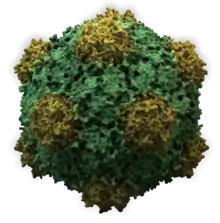Secoviridae
Secoviridae is a family of viruses in the order Picornavirales. Plants serve as natural hosts. There are 8 genera and 86 species in this family, one of which is unassigned to a genus.[1][2][3][4] The family was created in 2009 with the grouping of families Sequiviridae, now dissolved, and Comoviridae, now subfamily Comovirinae, along with the then unassigned genera Cheravirus, Sadwavirus, and Torradovirus.[4]
| Secoviridae | |
|---|---|
 | |
| Structure of the Cowpea mosaic virus based on PDB 2BFU | |
| Virus classification | |
| (unranked): | Virus |
| Realm: | Riboviria |
| Kingdom: | Orthornavirae |
| Phylum: | Pisuviricota |
| Class: | Pisoniviricetes |
| Order: | Picornavirales |
| Family: | Secoviridae |
| Genera | |
|
See text | |
Taxonomy
The family includes the following genera (-virinae denotes subfamily and -virus denotes genus):[4]
- Comovirinae
- Unassigned to a subfamily:
Lastly, one species is unassigned to a genus: Strawberry latent ringspot virus.
Structure
Viruses in Secoviridae are non-enveloped, with icosahedral geometries, and T=pseudo3 symmetry. The diameter is around 25-30 nm. Genomes are linear and segmented, bipartite, around 24-7kb in length.[1][2][3]
| Genus | Structure | Symmetry | Capsid | Genomic arrangement | Genomic segmentation |
|---|---|---|---|---|---|
| Sequivirus | Icosahedral | Pseudo T=3 | Non-enveloped | Linear | Monopartite |
| Sadwavirus | Icosahedral | Pseudo T=3 | Non-enveloped | Linear | Segmented |
| Nepovirus | Icosahedral | Pseudo T=3 | Non-enveloped | Linear | Segmented |
| Fabavirus | Icosahedral | Pseudo T=3 | Non-enveloped | Linear | Segmented |
| Comovirus | Icosahedral | Pseudo T=3 | Non-enveloped | Linear | Segmented |
| Cheravirus | Icosahedral | Pseudo T=3 | Non-enveloped | Linear | Segmented |
| Torradovirus | Icosahedral | Pseudo T=3 | Non-enveloped | Linear | Segmented |
| Waikavirus | Icosahedral | Pseudo T=3 | Non-enveloped | Linear | Monopartite |
Life cycle
Viral replication is cytoplasmic. Entry into the host cell is achieved by penetration into the host cell. Replication follows the positive stranded RNA virus replication model. Positive stranded RNA virus transcription is the method of transcription. The virus exits the host cell by tubule-guided viral movement. Plants serve as the natural host. Transmission routes are mechanical.[1][2][3]
| Genus | Host details | Tissue tropism | Entry details | Release details | Replication site | Assembly site | Transmission |
|---|---|---|---|---|---|---|---|
| Sequivirus | Plants | None | Viral movement; mechanical inoculation | Viral movement | Cytoplasm | Cytoplasm | Mechanical inoculation: aphids; Mechanical inoculation: Cavariella aegopodii; Mechanical inoculation: Cavariella pastinacae |
| Sadwavirus | Plants | None | Viral movement; mechanical inoculation | Viral movement | Cytoplasm | Cytoplasm | Nematodes; mites; thrips |
| Nepovirus | Plants | None | Viral movement; mechanical inoculation | Viral movement | Cytoplasm | Cytoplasm | Nematodes; mites; thrips |
| Fabavirus | Plants | None | Viral movement; mechanical inoculation | Viral movement | Cytoplasm | Cytoplasm | Mechanical inoculation: aphids |
| Comovirus | Plants | None | Viral movement; mechanical inoculation | Viral movement | Cytoplasm | Cytoplasm | Mechanical inoculation: beetles |
| Cheravirus | Plants | None | Viral movement; mechanical inoculation | Viral movement | Cytoplasm | Cytoplasm | Nematodes; mites; thrips |
| Torradovirus | Plants | None | Viral movement; mechanical inoculation | Viral movement | Cytoplasm | Cytoplasm | Unknown |
| Waikavirus | Gramineae | Phloem; phloem parenchyma; bundle sheath | Viral movement | Viral movement | Cytoplasm | Cytoplasm | Mechanical innocuation: aphids; mechanical innocuation: leafhoppers |
Evolution
The subfamily Comovirinae evolved ~1,000 years ago with extant species diversifying between 50 and 250 years ago.[5] This time period coincides with the intensification of agricultural practices in industrial societies.
The mutation rate has been estimated to be 9.29×10−3 to 2.74×10−3 subs/site/year.
References
- Thompson, JR; Dasgupta, I; Fuchs, M; Iwanami, T; Karasev, AV; Petrzik, K; Sanfaçon, H; Tzanetakis, I; van der Vlugt, R; Wetzel, T; Yoshikawa, N; ICTV Report Consortium (April 2017). "ICTV Virus Taxonomy Profile: Secoviridae". The Journal of General Virology. 98 (4): 529–531. doi:10.1099/jgv.0.000779. PMC 5657025. PMID 28452295.
- "Secoviridae". ICTV Online (10th) Report.
- "Viral Zone". ExPASy. Retrieved 15 June 2015.
- "Virus Taxonomy: 2020 Release". International Committee on Taxonomy of Viruses (ICTV). March 2021. Retrieved 20 May 2021.
- Thompson, JR; Kamath, N; Perry, KL (2014). "An evolutionary analysis of the secoviridae family of viruses". PLOS ONE. 9 (9): e106305. Bibcode:2014PLoSO...9j6305T. doi:10.1371/journal.pone.0106305. PMC 4152289. PMID 25180860.
External links
- ICTV Online (10th) Report: Secoviridae
- Viralzone: Secoviridae
- UniProt Taxonomy